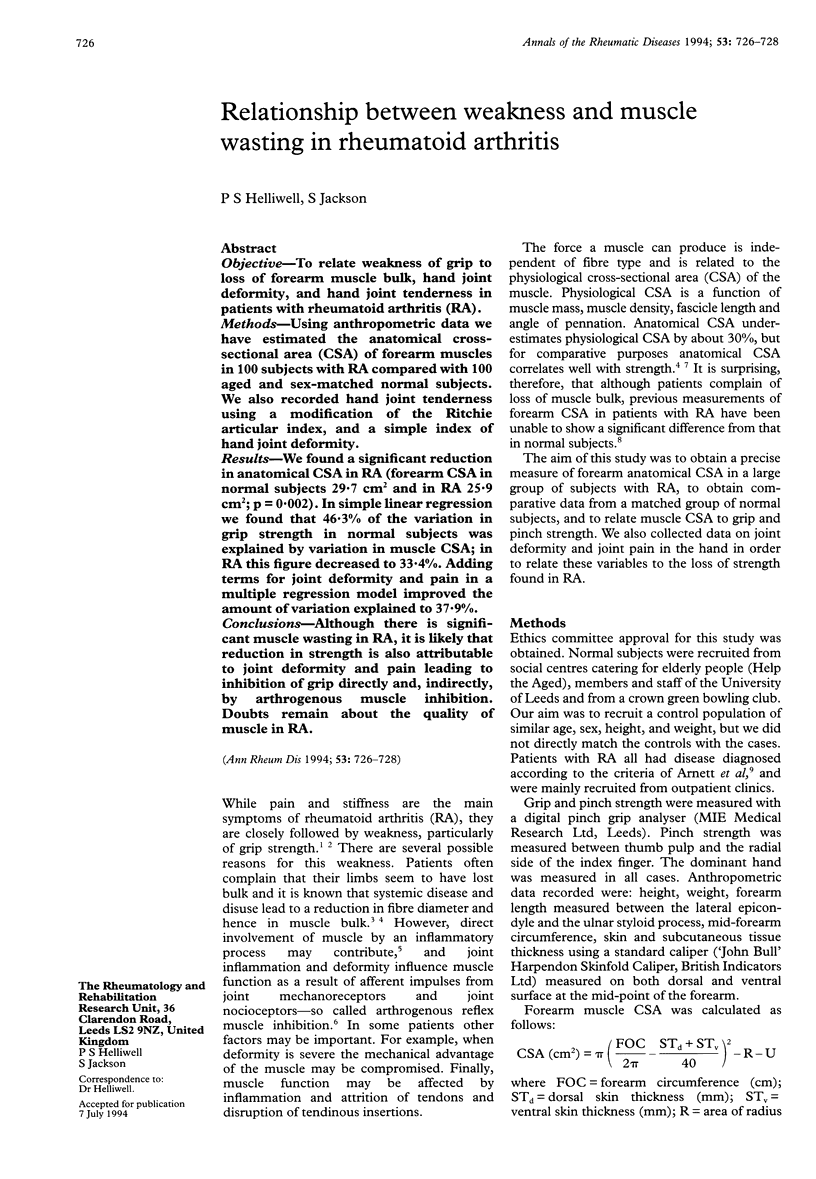Abstract
OBJECTIVE--To relate weakness of grip to loss of forearm muscle bulk, hand joint deformity, and hand joint tenderness in patients with rheumatoid arthritis (RA). METHODS--Using anthropometric data we have estimated the anatomical cross-sectional area (CSA) of forearm muscles in 100 subjects with RA compared with 100 aged and sex-matched normal subjects. We also recorded hand joint tenderness using a modification of the Ritchie articular index, and a simple index of hand joint deformity. RESULTS--We found a significant reduction in anatomical CSA in RA (forearm CSA in normal subjects 29.7 cm2 and in RA 25.9 cm2; p = 0.002). In simple linear regression we found that 46.3% of the variation in grip strength in normal subjects was explained by variation in muscle CSA; in RA this figure decreased to 33.4%. Adding terms for joint deformity and pain in a multiple regression model improved the amount of variation explained to 37.9%. CONCLUSIONS--Although there is significant muscle wasting in RA, it is likely that reduction in strength is also attributable to joint deformity and pain leading to inhibition of grip directly and, indirectly, by arthrogenous muscle inhibition. Doubts remain about the quality of muscle in RA.
Full text
PDF


Selected References
These references are in PubMed. This may not be the complete list of references from this article.
- Arnett F. C., Edworthy S. M., Bloch D. A., McShane D. J., Fries J. F., Cooper N. S., Healey L. A., Kaplan S. R., Liang M. H., Luthra H. S. The American Rheumatism Association 1987 revised criteria for the classification of rheumatoid arthritis. Arthritis Rheum. 1988 Mar;31(3):315–324. doi: 10.1002/art.1780310302. [DOI] [PubMed] [Google Scholar]
- Bruce S. A., Newton D., Woledge R. C. Effect of subnutrition on normalized muscle force and relaxation rate in human subjects using voluntary contractions. Clin Sci (Lond) 1989 Jun;76(6):637–641. doi: 10.1042/cs0760637. [DOI] [PubMed] [Google Scholar]
- Davies C. T., Thomas D. O., White M. J. Mechanical properties of young and elderly human muscle. Acta Med Scand Suppl. 1986;711:219–226. doi: 10.1111/j.0954-6820.1986.tb08954.x. [DOI] [PubMed] [Google Scholar]
- Haslock D. I., Wright V., Harriman D. G. Neuromuscular disorders in rheumatoid arthritis. A motor-point muscle biopsy study. Q J Med. 1970 Jul;39(155):335–358. [PubMed] [Google Scholar]
- Helliwell P., Howe A., Wright V. Functional assessment of the hand: reproducibility, acceptability, and utility of a new system for measuring strength. Ann Rheum Dis. 1987 Mar;46(3):203–208. doi: 10.1136/ard.46.3.203. [DOI] [PMC free article] [PubMed] [Google Scholar]
- Heymsfield S. B., McManus C., Smith J., Stevens V., Nixon D. W. Anthropometric measurement of muscle mass: revised equations for calculating bone-free arm muscle area. Am J Clin Nutr. 1982 Oct;36(4):680–690. doi: 10.1093/ajcn/36.4.680. [DOI] [PubMed] [Google Scholar]
- Horsman A., Leach A. E. The estimation of the cross-sectional area of the ulna and radius. Am J Phys Anthropol. 1974 Mar;40(2):173–185. doi: 10.1002/ajpa.1330400204. [DOI] [PubMed] [Google Scholar]
- Hurley M. V., Newham D. J. The influence of arthrogenous muscle inhibition on quadriceps rehabilitation of patients with early, unilateral osteoarthritic knees. Br J Rheumatol. 1993 Feb;32(2):127–131. doi: 10.1093/rheumatology/32.2.127. [DOI] [PubMed] [Google Scholar]
- Ikai M., Fukunaga T. Calculation of muscle strength per unit cross-sectional area of human muscle by means of ultrasonic measurement. Int Z Angew Physiol. 1968;26(1):26–32. doi: 10.1007/BF00696087. [DOI] [PubMed] [Google Scholar]
- Lee P., Baxter A., Dick W. C., Webb J. An assessment of grip strength measurement in rheumatoid arthritis. Scand J Rheumatol. 1974;3(1):17–23. doi: 10.3109/03009747409165124. [DOI] [PubMed] [Google Scholar]
- Lenman J. A., Potter J. L. Electromyographic measurement of fatigue in rheumatoid arthritis and neuromuscular disease. Ann Rheum Dis. 1966 Jan;25(1):76–84. [PMC free article] [PubMed] [Google Scholar]
- Maughan R. J., Nimmo M. A. The influence of variations in muscle fibre composition on muscle strength and cross-sectional area in untrained males. J Physiol. 1984 Jun;351:299–311. doi: 10.1113/jphysiol.1984.sp015246. [DOI] [PMC free article] [PubMed] [Google Scholar]
- Ritchie D. M., Boyle J. A., McInnes J. M., Jasani M. K., Dalakos T. G., Grieveson P., Buchanan W. W. Clinical studies with an articular index for the assessment of joint tenderness in patients with rheumatoid arthritis. Q J Med. 1968 Jul;37(147):393–406. [PubMed] [Google Scholar]
- Steinberg V. L., Parry C. B. Electromyographic Changes in Rheumatoid Arthritis. Br Med J. 1961 Mar 4;1(5226):630–632. doi: 10.1136/bmj.1.5226.630. [DOI] [PMC free article] [PubMed] [Google Scholar]
- Yung P., Unsworth A., Haslock I. Measurement of stiffness in the metacarpophalangeal joint: the effects of physiotherapy. Clin Phys Physiol Meas. 1986 May;7(2):147–156. doi: 10.1088/0143-0815/7/2/005. [DOI] [PubMed] [Google Scholar]


